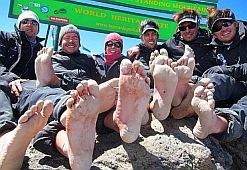
Barefoot on the Roof of Africa
South African mountain climbers can now relish the fact that they are the first people documented to ever climb Africa’s highest mountain, Mount Kilimanjaro, barefoot, and all done in the name of charity. With no serious injuries, all the climbers from Barefoot Impi – a group of adventurers and philanthropists who engage in charitable causes barefoot […]

South African mountain climbers can now relish the fact that they are the first people documented to ever climb Africa’s highest mountain, Mount Kilimanjaro, barefoot, and all done in the name of charity.

With no serious injuries, all the climbers from Barefoot Impi – a group of adventurers and philanthropists who engage in charitable causes barefoot – reached the summit of Kili.
Their feat was done in aid of the Red Cross War Memorial Children’s Hospital and Paediatric Healthcare in Cape Town, Western Cape Province. The expedition was sponsored by Old Mutual, a financial services provider.
There were 10 climbers in the team. Matt Botha, Dr Ross Tucker, Camilla Howard, Clyde Barendse, Andrew King and Hedley Young went shoeless, the others were guides and a camera man.
The money raised from the climb will go towards upgrading the hospital’s Poisons Information Centre.
Carla Goliath of the Children’s Hospital Trust said: “The money donated is still coming in and some have pledged donations which we have not yet received so the amount of money raised from the climb is still to be confirmed.”
The Children’s Hospital Trust is fundraisers for the Red Cross War Memorial Children’s Hospital.

Before their departure, Sean Disney, the managing director of Adventure Dynamics International, who has climbed Mount Everest and the Seven Summits twice, said: “The objective of the expedition is to climb and summit Kilimanjaro barefoot in entirety. This naturally poses a whole new array of additional challenges that one would have to overcome during a conventional summit.”
Tackling Kili
Tucker said: “Ultimately, to be perfectly honest, we were clinical, precise and got to the summit relatively easily. I’d go so far as to say that probably 80% of expeditions to Kilimanjaro have more problems and issues than we had.
“Perhaps being barefoot forced on us a more stringent approach, but it worked, and that should, I would hope, shake a paradigm or two.”
The team reached the summit of the 5 895m mountain, also known as the Mountain of Greatness and the Roof of Africa, in five days battling terrain, altitude and weather along the way.
They went through extensive training for months in advance, hiking barefoot up trails on Table Mountain and spending time in ice chambers at -15°. The mountaineers basically lived barefoot for months to give their feet the best possible chance against the elements on the mountain.
And all that training paid off. “We reached the peak as one very emotional tribe knowing we had achieved what we set out to do,” said King.
Tucker added: “I can honestly say that when all six of us got to the summit, with no drama, there was a feeling of vindication mixed with the happiness. All it took was planning and preparation with intelligence, foresight and discipline.”
Some of the rules for the hike included: walking barefoot from the gate of the mountain to its peak; set climbing times during each day and not placing a shoe of any kind on any foot during the set climbing times.
Why the upgrade is needed
There are only two 24-hour emergency poison lines available to the South African public and medical profession. They are based at the Tygerberg Hospital and Red Cross War Memorial Children’s hospitals, both in Cape Town.
Both use the database at the Red Cross hospital as their source of information.
According to the Children’s Hospital Trust, an upgraded, internet-based system is required that can be accessed on- and offline by medical professionals throughout southern Africa. This web-based system will allow rapid and immediate access to medical institutions and healthcare professionals, as well as provide information on non-toxic substances to the general public.
The cost to upgrade the Poisons Information Centre is R3.1-million (US$406 000).
Source:www.mediaclubsouthafrica.com
By:Ray Maota
